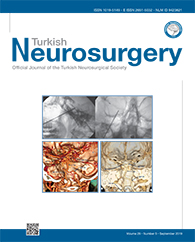2Nankai University, School of Medicine, Tianjin, China DOI : 10.5137/1019-5149.JTN.22603-18.2 AIM: To assess the endocrinological outcomes of high-field (1.5-T) intraoperative magnetic resonance imaging (iMRI)-guided endoscopic transsphenoidal surgery (TSS) for non-functioning pituitary adenomas (NFPAs).
MATERIAL and METHODS: Radiological and endocrinological data were retrospectively collected and analyzed for 133 consecutive patients who underwent iMRI-guided endoscopic TSS for NFPA.
RESULTS: Between the first and final scans, the gross total resection (GTR) rate increased from 42.9% to 63.9%. Preoperatively,
105 patients were deficient in at least 1 pituitary hormone axis (corticotroph axis: 51 patients, gonadotrope axis: 89 patients,
thyrotrope axis: 51 patients, growth hormone axis: 19 patients). After surgery, varying rates of improvement were observed in
patients with deficiencies in the growth hormone (89.5%), corticotroph (78.4%), gonadotrope (49.4%), and thyrotrope axes (33.3%).
Pituitary function deteriorated in 75 patients (corticotroph axis: 23 patients, gonadotrope axis: 30, thyrotrope axis: 56 patients).
Univariate logistic regression analyses revealed that, among patients with hypopituitarism of the gonadotrope axis, women were
more likely than men to experience recovery (odds ratio [OR]: 0.417, 95% confidence interval [CI]: 0.191â0.913; p=0.029) and not
experience deterioration (OR: 2.539, 95% CI: 1.057â6.098; p=0.037). The increased GTR rate, based on the iMRI findings, was not
associated with an increased incidence of postoperative hypopituitarism or lower recovery rates in the pituitary axes (both p>0.05).





